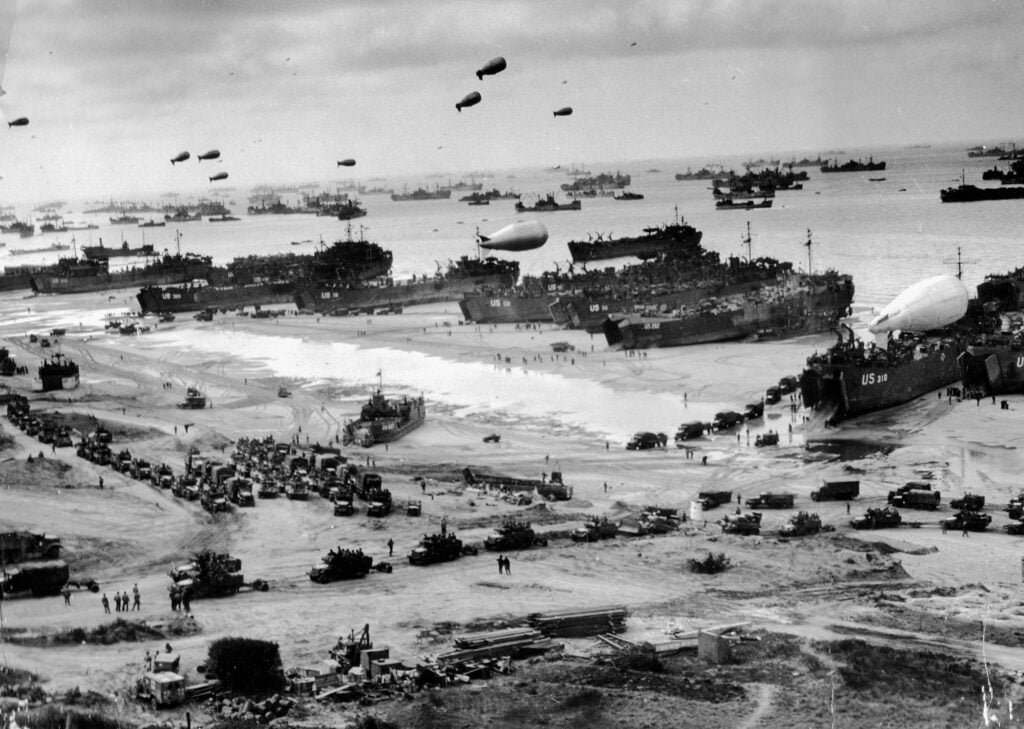Many different types of landing craft were used on D-Day, 6 June 1944, and during the rest of the 1944 Normandy campaign. Here is a list of the main types.
Minor Landing Craft
Minor landing craft were smaller, did not have accommodation for the crew and needed support from a larger ship.
LCA: Landing Craft, Assault
LCVP: Landing Craft, Vehicle, Personnel
LCP(L): Landing Craft, Personnel (Large)
LCM: Landing Craft, Mechanised
Major Landing Craft
Major landing craft had accommodation on board for the crew, and could act independently.
LCT: Landing Craft, Tank
LCI(L): Landing Craft, Infantry (Large)
LCI(S): Landing Craft, Infantry (Small)

Above: A well known photograph of Omaha Beach after D-Day. Note the variety of amphibious craft visible. A line of LSTs are beached at the water’s edge. Higher up the beach are several smaller vessels, including an LCM, a British LCT(3) or LCT(4), and a US LCT(6). Larger merchant ships are moored just off the beach, where they would be unloaded using a variety of landing craft plus barges and Rhino Ferries. (Photo: Conseil Régional de Basse-Normandie / US National Archives)
Control and Support Landing Craft
These craft were of varying sizes but all had roles other than landing forces on a beach. Some were unique designs while others were conversions of troop-carrying craft.
LCA(HR): Landing Craft, Assault (Hedgerow)
LCC: Landing Craft, Control
LCF: Landing Craft, Flak
LCG(L): Landing Craft, Gun (Large)
LCS(L): Landing Craft, Support (Large)
LCS(M): Landing Craft, Support (Medium)
LCS(S): Landing Craft, Support (Small)
LCT(R): Landing Craft, Tank (Rocket)
Landing Ships
Strictly speaking, landing ships were not landing craft! However they were closely associated, and often carried a number of landing craft on board.
LSD: Landing Ship, Dock
LSH: Landing Ship, Headquarters
LSI and APA troop transport ships: Landing Ship, Infantry; Auxiliary Personnel, Attack
LST: Landing Ship, Tank
Other types
Vessels, vehicles and equipment that were closely associated with landing craft.
Landing Barges
Related vessels and equipment
More about landing craft type names
To understand the types of landing craft used on D-Day you need to know more about their names.
Earlier in the war, British landing craft type names ended with the word ‘craft’: for example ‘Assault Landing Craft’. After the USA joined the war, the names were standardised for consistency across Allied countries. The American style was adopted, in which all names began with the words ‘landing craft…’ – for example ‘Landing Craft, Assault’.
Often there were several variants or Marks within each type of craft, designated by a number in brackets: for example LCT(3) means LCT Mark 3. Each was a development of or improvement on the earlier types. For example there were two marks of LCM (Mks.1 and 3), and four marks of LCT (Mks. 3, 4, 5 and 6 – plus the Mk.3* which was a modified Mk.3).
Allied landing craft had numbers rather than names as would be the case with larger ships. These were known as pennant numbers to the British, and hull numbers to the US. Officially, landing craft numbers were preceded by “USS” or “HMS” as appropriate, but in practice this was often omitted.